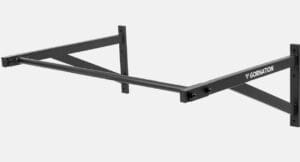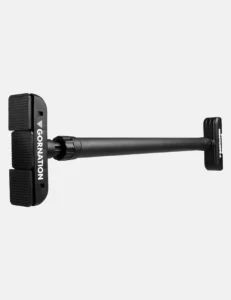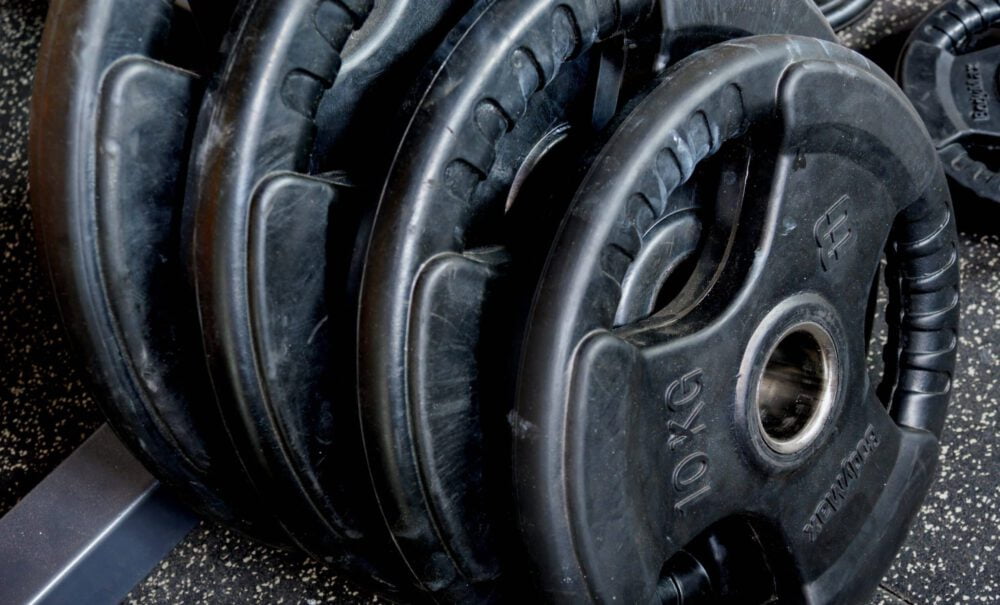Looking for the best pull-up bar to use at home? We’ve rounded up our favorite options for doorways, walls, ceilings, and even full pull-up stations. Each one has been tested for sturdiness, easy setup, and overall value. Check out the top picks below and find the bar that fits your home workouts best.
Navigate
Types of Pull-Up Bars
In this guide, you’ll find an overview of the most popular types of pull-up bars:
- Pull-up station / Power Tower
- Wall-mounted pull-up bar
- Doorway pull-up bar
- Ceiling pull-up bar
We’ll walk you through the benefits of each type and show you the best options right away. That way, you can skip the endless searching and quickly find the bar that suits you best.
pull-up station
A pull-up station, often called a power tower, is one of the most complete options for home. With a single station, you can train pull-ups, chin-ups, dips, L-sits, and sometimes even muscle-ups. It’s a versatile solution for anyone who wants to take calisthenics seriously.
When should you choose a pull-up station?
A pull-up station is the best choice if you’ve got both the budget and the space. It gives you a complete training setup at home where you can do pull-ups, chin-ups, dips, L-sits, and even muscle-ups. Everything you need for a full home workout is right there.
Cheaper alternatives are often unstable, which makes your training less safe and comfortable. A solid station, on the other hand, gives you stability and quality. Prefer working out at home instead of outside? Then a pull-up station is perfect, since you can train anytime without depending on the weather or a public bar.
That’s why a pull-up station is ideal for anyone serious about calisthenics and ready to invest in a durable long-term solution.
Best pull up station
Our top pick for this type is the Gornation Premium Pull-Up Station. It’s sturdy, easy to set up, and suitable for both beginners and advanced athletes. Thanks to its stable design, you can use it for pull-ups, dips, and even core exercises.
Benefits of the Gornation Premium Pull-Up Station:
- Stable and safe, even during intense workouts
- No wall or ceiling installation required
- Perfect for pull-ups, dips, and more
- High-quality finish and long-lasting durability
- Supports heavy loads
Use discount code Heavyweight10 to get 10% off your order at Gornation.
Wall mounted pull-up bar
Want a solid pull-up bar that will last for years and handle anything, even extra weight? Then a wall-mounted pull-up bar is your best choice. This type is fixed securely to the wall, so you can train confidently with weighted pull-ups and muscle-ups.
When should you choose a wall-mounted pull-up bar?
A wall-mounted pull-up bar is the best option if you want a fixed and sturdy solution at home. Since it’s mounted directly to the wall, it’s extremely stable and perfect for intense exercises like pull-ups, chin-ups, L-sits, and even weighted workouts.
Unlike freestanding or doorway models, you don’t have to worry about instability. Cheaper alternatives can shift or wobble, but a wall bar always stays in place. If you’ve got a solid wall and enough space to mount it properly, this is the most durable choice.
That’s why a wall-mounted pull-up bar is ideal for anyone who wants a permanent training spot and is ready to invest in long-term calisthenics progress.
Best Wall mounted pull-up bar
Our recommendation is the Gornation Wall Mounted Pull-Up Bar Medium. This pull-up bar is designed for athletes looking for a stable and durable solution at home, outdoors, or in the garage. Its solid build lets you train hard without any wobbling or sagging. It’s available in both an indoor and an outdoor pull-up bar version.
Benefits of the Gornation Wall Mounted Pull-Up Bar:
- Extremely stable, perfect for weighted calisthenics
- High load capacity with secure anchoring
- Suitable for intense strength training
- Durable steel with a premium finish
- Compact design
Use discount code Heavyweight10 to get 10% off at Gornation.
Doorway Pull-Up Bar
The main reasons to go for this option are price and convenience.
A doorway pull-up bar is much cheaper than the other types, making it a great choice if you want to train at home on a budget.
It’s also ideal if you don’t have the space or option to mount a bar on the wall. Not everyone is allowed to drill holes in a rental home.
Doorway pull-up bars are easy to hang up when you need them, and you can store them away after your workout so they won’t get in the way.
Why shouldn’t you choose a doorway pull-up bar?
When you hang a pull-up bar on your doorway, it will never be as sturdy as one that’s mounted to the wall. If stability is your top priority, I’d recommend going for a wall-mounted pull-up bar or a power station.
Best in between doorway pull-up bar
The Gornation Pull-Up Bar is a great choice if you’re looking for a sturdy and versatile doorway pull-up bar. What makes this bar stand out is its user-friendly design, you don’t need to drill any holes to install it. It’s easy to set up and adjustable in width, making it fit a wide range of doorframes.
With its stability and impressive weight capacity of up to 200 kg, this bar works for both beginners and advanced athletes. Plus, the smart design allows you to store it compactly, which is perfect for smaller spaces.
Best anchored pull-up bar
The Pullup & Dip Door Anchored Pull-Up Bar is one of the best options if you’re looking for a sturdy and versatile anchored pull-up bar. Its biggest advantage is that it extends above the doorframe, making it especially suitable for taller athletes. This gives you more space compared to a bar placed inside the frame.
This bar also offers multiple grip positions, allowing you to switch up your training and target different muscle groups effectively. On top of that, it’s designed to fit both smaller and larger doors, giving you extra flexibility.
Ceiling Pull-Up Bar
When mounting to the wall or door isn’t an option, a ceiling pull-up bar can be the perfect solution. This type of bar offers excellent stability and often more room to move, giving you greater variety in your workouts. It’s ideal if you want to train seriously at home and have enough space to mount it to the ceiling.
When should you choose a ceiling pull-up bar?
A ceiling pull-up bar is the best choice if you want maximum freedom of movement during your workouts. Since it’s mounted to the ceiling, you won’t be limited by walls or doorframes, and you can perform wide pull-ups, muscle-ups, or kipping variations without restrictions.
While cheaper alternatives often feel cramped or unstable, a ceiling bar provides both stability and freedom. You do need a solid ceiling and enough height to move comfortably. If you’ve got that, this is a long-lasting solution that will serve you for years.
That’s why a ceiling pull-up bar is perfect for athletes who want to get the most out of their training and are ready to invest in a permanent setup.
Best ceiling pull-up bar
Our recommendation is the Gornation Pull-Up Bar Multi. This bar is built for maximum versatility and durability. With its high load capacity and generous range of motion, you can go beyond standard pull-ups and train muscle-ups, weighted pull-ups, front lever, and back lever.
Benefits of the Gornation Pull-Up Bar Multi:
- Ceiling-mounted for extra stability
- High load capacity (200 kg)
- Perfect for intense strength training
- Strong and durable materials
- Plenty of space for a wide range of exercises
- Great for a home gym or garage
Use discount code Heavyweight10 to get 10% off at Gornation.
What to consider when buying a pull-up bar?
There are many different types of pull-up bars and chin-up bars available. Therefore, it’s important to first determine your specific needs before making a purchase. Below are some points to consider when choosing a pull-up bar or pull-up bar:
Material
Pull-up bars / chin-up bars are made of different materials, such as steel or aluminum. Steel is sturdy and durable but can be heavy and prone to rust if not coated. Aluminum is lightweight and rust-resistant but is less strong than steel.
Weight
The weight of a pull-up bar or pull-up bar is important if you plan to hang it on the ceiling or wall. A lighter bar is easier to move but may be less sturdy, while a heavier bar is often more stable.
Weight capacity
Most pull-up bars have a weight limit ranging from 220 to 440 pounds. This provides enough leeway to also train weighted pull-ups.
However, it’s important to align the weight limit with your training goals. If you aim to do many (heavy) pull-ups, a pull-up bar that clamps between the door frame may be less practical than a power tower or a wall-mounted pull-up bar.
Additionally, consider the load-bearing capacity of the wall or door frame. Therefore, it’s advisable to cautiously test a bar before putting your full weight on it.
Height
Additionally, it’s important to consider the height you think you’ll need. For tall individuals, it may be more convenient to mount a bar on the wall, as this provides more flexibility in height compared to a door frame or power tower.
Pull up bar installation
Setting up the pull-up bar can be quite a task, varying depending on the type of pull-up bar.
To assemble the wall-mounted pull-up bar, you’ll need to drill holes into a sturdy wall. It’s advisable to have at least two people for this task, but preferably three, as someone will need to hold the bar in place.
Most door-mounted pull-up bars are easy to set up and typically take less than 10 minutes, even when done alone. This makes them ideal for those less inclined towards technical tasks.
Setting up a pull-up station or power tower is also manageable. Most models come as DIY kits, similar to IKEA furniture, and can be assembled on your own. However, it’s crucial to allocate enough time to ensure stability, as a wobbly pull-up bar can be quite bothersome.
Additional exercise possibilities
Do you want to train not only pull-ups but also, for example, dips? Then it’s wise to opt for a pull-up station that also includes a dip bar. With one device, you have a wide range of exercises covered.
Space
How much space do you have to hang the pull-up bar, and where do you want to hang it? Check if your walls / door frames are strong enough to hang a pull-up bar on. Or see if you have enough space for a pull-up station.
Training with your pull up bar
Do you want to train at home but have no idea where to start? Download our calisthenics workout plan below and get started right away!
Frequently asked questions
What are pull-ups good for?
By training pull-ups, you increase strength and stimulate muscle growth primarily in your back muscles, forearms, and biceps. However, the pull-up is a compound exercise, meaning that you engage a large number of muscles. In addition to the back, forearms, and biceps, other muscles such as the shoulders, abdomen, and triceps are also trained to a lesser extent during the pull-up.
What exercises can you train with a pull-up bar?
You can train a variety of exercises with a pull-up bar, making it a versatile piece of calisthenics equipment. Below are some examples of the most popular exercises:
Pull-ups: Hanging from the bar with a pronated grip (palms facing away from you), pull your body up until your chin is above the bar. This exercise is excellent for training the back and arm muscles.
Chin-ups: Similar to pull-ups but with a supinated grip (palms facing towards you), targeting the biceps more than pull-ups.
Leg raises: Hang from the bar with a pronated grip and lift your legs until they are parallel to the ground or, for advanced practitioners, until your toes touch the bar. This exercise primarily targets the abdominal muscles.
Knee raises: Hang from the bar with a pronated grip and bring your knees towards your chest. This is an easier variation of leg raises.
Front lever: This is an isometric exercise where you bring your body parallel to the ground with your face towards the bar.
Back lever: Another isometric exercise where you position your body horizontally under the bar, facing the ground.
For all these exercises, it’s important to use proper technique and perform the correct number of sets and reps. Failing to do so can increase the risk of injury. If you’re just starting out, consider seeking guidance from an (online) coach or fitness trainer.
How many pull ups to train every day?
If you plan to train pull-ups every day, it’s important not to train your maximum number of reps every day as you can quickly become overstrained. A good guideline is to aim for sets of about 50-60% of your maximum number of reps per set as a baseline. You can then perform this number several times throughout the day.
What is the ideal height of a pull-up bar?
The minimum height for a pull-up bar is the height at which you don’t touch the floor when hanging under the bar with your knees bent. The ideal height is when you can hang from the bar with your legs extended and just not touch the ground. With this height, you can also effectively use resistance bands for your pull-ups.
Additional calisthenics equipment
A pull-up bar or chin-up bar is a fantastic addition to your home gym, but it’s not the only tool you need for a complete home workout.
Below are some other materials that make excellent additions to your home gym:
Calisthenics rings: Rings are an ideal complement to your pull-up bar, allowing you to intensify your workout easily. They also offer the opportunity to train push exercises like dips, which may not be possible with just a pull-up bar.
Dip belt + weights: When pull-ups become easy, it’s important to make your training more challenging. Easily do this by adding weights using a weight belt.
Weighted vest: Another way to increase the difficulty of your training is by wearing a weighted vest.
Resistance bands: If you’re still mastering pull-ups, resistance bands are perfect for assisting you with those initial reps. They make the workout lighter, allowing your body to gradually adjust to the new exercises.
Push-up bars / parallettes: Want more variety in your push-up routine? You can easily achieve this by purchasing a set of push-up bars or parallettes.
Dip station: Do you want to train weighted dips at home? Then I recommend purchasing a dip station.
It’s not necessary to buy all these items at once. Start your calisthenics home gym with the materials you think will benefit you the most and gradually expand from there.
Conclusion
A home pull-up bar is the best investment you can make for your health. There’s a good option available for every budget, so what are you waiting for? Get one and start training.
















